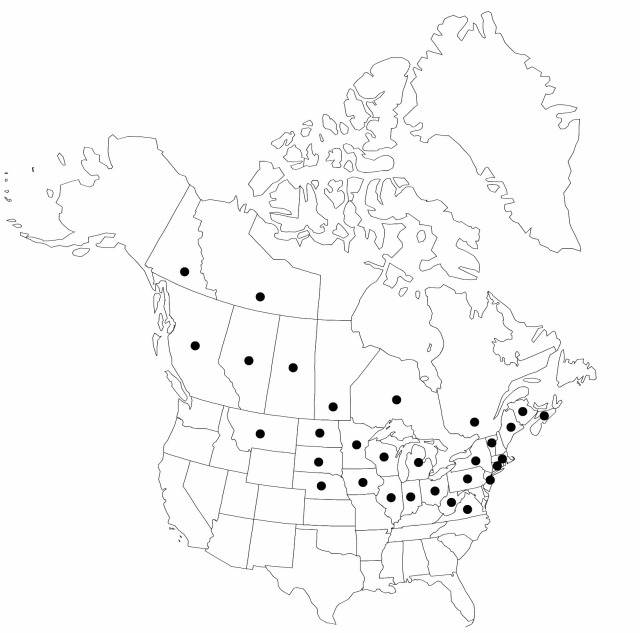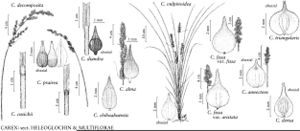Difference between revisions of "Carex prairea"
in Alph. Wood, Class-book Bot., 414. 1845 (as prarisa).
ed. 2, 578. 1847.
FNA>Volume Importer |
imported>Volume Importer |
||
| (One intermediate revision by the same user not shown) | |||
| Line 1: | Line 1: | ||
{{Treatment/ID | {{Treatment/ID | ||
|accepted_name=Carex prairea | |accepted_name=Carex prairea | ||
| − | |accepted_authority=Dewey | + | |accepted_authority=Dewey |
|publications={{Treatment/Publication | |publications={{Treatment/Publication | ||
|title=in Alph. Wood, Class-book Bot., | |title=in Alph. Wood, Class-book Bot., | ||
| Line 11: | Line 11: | ||
}} | }} | ||
|common_names=Carex des prairies | |common_names=Carex des prairies | ||
| + | |special_status={{Treatment/ID/Special_status | ||
| + | |code=F | ||
| + | |label=Illustrated | ||
| + | }}{{Treatment/ID/Special_status | ||
| + | |code=E | ||
| + | |label=Endemic | ||
| + | }} | ||
|basionyms= | |basionyms= | ||
|synonyms={{Treatment/ID/Synonym | |synonyms={{Treatment/ID/Synonym | ||
| Line 41: | Line 48: | ||
-->{{#Taxon: | -->{{#Taxon: | ||
name=Carex prairea | name=Carex prairea | ||
| − | |authority=Dewey | + | |authority=Dewey |
|rank=species | |rank=species | ||
|parent rank=section | |parent rank=section | ||
| Line 54: | Line 61: | ||
|publication title=in Alph. Wood, Class-book Bot.,;ed. | |publication title=in Alph. Wood, Class-book Bot.,;ed. | ||
|publication year=;1847 | |publication year=;1847 | ||
| − | |special status= | + | |special status=Illustrated;Endemic |
| − | |source xml=https:// | + | |source xml=https://bitbucket.org/aafc-mbb/fna-data-curation/src/2e0870ddd59836b60bcf96646a41e87ea5a5943a/coarse_grained_fna_xml/V23/V23_473.xml |
|genus=Carex | |genus=Carex | ||
|section=Carex sect. Heleoglochin | |section=Carex sect. Heleoglochin | ||
Latest revision as of 20:41, 5 November 2020
Culms 3–6 cm (fl), elongating to 6–100 cm (fr). Leaves: sheaths adaxially strongly copper colored distally, truncate to convex at mouth, prolonged 2–8 mm beyond base of blade; ligules 1.2–5.8(–9.2) mm; foliage leaf blades 6–50 cm × 2–3 mm. Inflorescences bisexual or, sometimes, nearly or wholly unisexual, flexuous and interrupted, proximal 1–5 branches often separated, decompound, 3–8(–9) × (0.4–)0.8–1.8 cm; basal branch with (2–)4–10 spikes; proximal internode 7–26(–33) mm. Pistillate scales light reddish brown, 2.4–3.3 × (1.1–)1.4–2.1 mm, as wide as or wider than perigynia. Perigynia appressed or ascending, straw colored to light or dark brown, strongly 6–9-veined abaxially, with or without median lengthwise groove near base, sometimes membranous flap toward apex, lance-ovate (body ovate to very widely ovate) in outline, plano-convex, (2.1–)2.3–3(–3.3) × (1–)1.1–1.4 mm, dull; beak 0.8–1.4 mm. Achenes broadly or very broadly trullate-ovate in outline, 1.2–1.6 × 0.7–1 mm. 2n = 66.
Phenology: Fruiting Jun–Jul (Aug in w Canada).
Habitat: Wet meadows, peaty ground, usually in calcareous marshes, prairies, fens, and swales, often on borders of lakes and streams or in open conifer swamps (Larix, Picea, Thuja), also thickets and ditches
Elevation: 0–1400 m
Distribution

Alta., B.C., Man., N.B., N.W.T., N.S., Ont., Que., Sask., Yukon, Conn., Ill., Ind., Iowa, Maine, Mass., Mich., Minn., Mont., Nebr., N.J., N.Y., N.Dak., Ohio, Pa., S.Dak., Vt., Va., W.Va., Wis.
Discussion
The geographic range of Carex prairea is rather fragmented except for a core zone that extends from southern Quebec and New England to Alberta. Oregon, Idaho, Wyoming, and California reports should probably be referred to C. cusickii or some other species, because south of the Canadian border (except for one locality in western Montana), C. prairea is unknown from west of the Great Plains. Carex appropinquata Schumacher, reported from Manitoba by W. J. Hooker ([1829–]1840, as C. paradoxa Willdenow) and from Colorado by L. Kelso (1953, 1953b), must be excluded. Hooker’s citation possibly refers to C. praegracilis W. Boott or less likely to C. prairea, and Kelso’s specimens (in US) are C. praegracilis.
Carex prairea and C. diandra are closely related and may not appear to be sharply differentiated. However, they maintain separate identities throughout their overlapping ranges and prefer subtly different habitats. Carex prairea is strictly calcicolous, avoiding saline groundwater and oligotrophic muskegs, whereas C. diandra does not require calcareous conditions and so is more likely to be found, for example, in New England and the Canadian Shield region.
Selected References
None.
